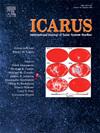最近一块巨石落在月球上
IF 2.5
2区 物理与天体物理
Q2 ASTRONOMY & ASTROPHYSICS
引用次数: 0
摘要
月球巨石坠落的痕迹表明了最近的地表活动,然而,到目前为止,还没有系统的尝试来确定最近坠落的地点,而且坠落的时间到底有多近仍然是难以捉摸的。我们的研究绘制了最近在±40°纬度范围内的巨石坠落图,通过沿轨道存在的巨石反弹引起的抛射来确定,称为巨石坠落抛射(BFE)。综合调查发现了245条长度为~ 373公里的轨道,与没有这种喷射物的经典巨石轨道明显不同。我们发现46%的BFE轨道位于马海地区,54%位于高地地区,这表明马海地区的瀑布相对较多,因为这里的陡坡较少。我们报告说,在我们绘制的位置中,约62%的位置有多个BFE轨道,这表明在这些区域内有更多的巨石落下。将BFE的足迹与其环境区域相结合,揭示了撞击引发的巨石坠落的第一个地貌证据。我们发现拥有BFE轨道的新陨石坑有100 Ka的历史,这意味着BFE轨道甚至更近。我们在阿波罗17号的Lee-Lincoln断崖附近观察到BFE轨迹,并在阿波罗号地震震中/褶皱脊/裂片断崖附近观察到其他一些位置,我们假设这些位置是潜在的热点。我们从这些BFE轨迹的空间分布推断,各种触发因素在导致最近的下降中发挥了作用。有了这些新发现的BFE轨道,月球加入了地球和火星的行列,最近由多个来源驱动的巨石坠落记录表明月球偶尔活跃。这些地区可能是未来任务的潜在着陆点,以了解月球最近的表面/地下活动。本文章由计算机程序翻译,如有差异,请以英文原文为准。
Recent boulder falls on the Moon
Lunar boulder fall tracks indicate recent surface activity, however, to date there has been no systematic attempt to identify recent fall locations and it remains elusive that how recent the falls actually are. Our study mapped the recent boulder falls located within ±40° latitude, identified by the presence of boulder bounce-induced ejecta along the tracks referred to as Boulder Fall Ejecta (BFE). Our comprehensive survey revealed 245 tracks with ∼373 km total length, which are clearly distinguishable from classical boulder tracks, which lack such ejecta. We found 46 % of BFE tracks are located on the Mare and 54 % in Highland regions, suggesting relatively more falls in the Mare region, as there are fewer steep slopes here. We report that ∼62 % of our mapped locations host multiple BFE tracks, which indicates more boulder falls within those regions. Placing the BFE tracks with their contextual region revealed the first geomorphic evidence for impact ejected/triggered boulder falls. We find that fresh craters hosting the BFE tracks are a few 100 Ka old, meaning that the BFE tracks are even more recent. We observed BFE tracks adjacent to the Lee-Lincoln scarp at the Apollo17 site and a few other locations neighboring to Apollo seismic epicenters/wrinkle ridge/lobate scarps, which we hypothesize as potential hotspots. We infer from the spatial distribution of these BFE tracks that various triggers have played a role in causing the recent falls. With these newly found BFE tracks, the Moon joins Earth and Mars, with records of recent boulder falls driven by multiple sources suggesting a sporadically active Moon. Such regions could be potential landing sites for future missions to understand the recent surface/subsurface activity on the Moon.
求助全文
通过发布文献求助,成功后即可免费获取论文全文。
去求助
来源期刊

Icarus
地学天文-天文与天体物理
CiteScore
6.30
自引率
18.80%
发文量
356
审稿时长
2-4 weeks
期刊介绍:
Icarus is devoted to the publication of original contributions in the field of Solar System studies. Manuscripts reporting the results of new research - observational, experimental, or theoretical - concerning the astronomy, geology, meteorology, physics, chemistry, biology, and other scientific aspects of our Solar System or extrasolar systems are welcome. The journal generally does not publish papers devoted exclusively to the Sun, the Earth, celestial mechanics, meteoritics, or astrophysics. Icarus does not publish papers that provide "improved" versions of Bode''s law, or other numerical relations, without a sound physical basis. Icarus does not publish meeting announcements or general notices. Reviews, historical papers, and manuscripts describing spacecraft instrumentation may be considered, but only with prior approval of the editor. An entire issue of the journal is occasionally devoted to a single subject, usually arising from a conference on the same topic. The language of publication is English. American or British usage is accepted, but not a mixture of these.
 求助内容:
求助内容: 应助结果提醒方式:
应助结果提醒方式:


